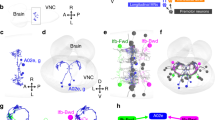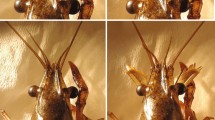Summary
Premotor interneurons involved in the abdominal positioning behaviors of the crayfish,Procambarus clarkii, were studied intracellularly, along with motoneuron activity, in semi-intact preparations during episodes of fictive behavior. Each impaled cell was tested by injecting depolarizing current and examining the motor output. If a response was evoked then the cell was classified as a flexion-producing interneuron (FPI), extension-producing interneuron (EPI) or mixed output interneuron (MOI). A platform drop/rise procedure was then used to elicit abdominal extension-like and flexion-like responses. Interneurons that were active during positioning behavior were silenced by hyperpolarization to determine their contribution in generating the underlying motor program. The data were used to assess the degree of participation of these interneurons in abdominal positioning behavior. Fewer than half of the FPIs, EPIs and MOIs became active during the behavioral episodes. Strength of response to depolarizing current was not correlated with the probability that a cell would fire during behavior. Hyperpolarization tests showed that typical FPIs, EPIs and MOIs were only responsible for a small part of the overall motor output. Also, interneurons, regardless of their FPI or EPI classification, were often observed to fire during both flexion-like and extension-like behaviors.
Responses of FPIs, EPIs and MOIs to repeated platform movements suggest that these cells may fire according to a probability distribution depending on: (1) strength of the stimulus; (2) location of the stimulus; (3) location of the interneuron. Most identified cells could not readily be assigned to a specific behavior except for the ‘T’ cell type, which seems intimately involved in most flexion behaviors.
The results of this study support the hypothesis that there are few if any ‘command neurons’, as defined by Kupfermann and Weiss (1978), in the crayfish abdominal positioning system. Abdominal positioning behavior, therefore, is probably under the control of a large network of cells each contributing a small part to the overall motor output.
Similar content being viewed by others
Abbreviations
- FPI :
-
flexion-producing interneuron
- EPI :
-
extension-producing interneuron
- MOI :
-
mixed output interneuron
- SFMN :
-
superficial flexor motoneuron
- SEMN :
-
superficial extensor motoneuron
References
Evoy WH, Kennedy D (1967) The central nervous organization underlying control of antagonistic muscles in the crayfish. I. Types of command fibers. J Exp Zool 165:223–238
Harreveld A van (1936) A physiological solution for fresh water crustaceans. Proc Soc Exp Biol Med 34:428–432
Hensler K (1988) Intersegmental interneurons involved in the control of head movements in crickets. J Comp Physiol A 162:111–126
Jellies JA (1984) Premotor interneurons involved in abdominal positioning in crayfish: Synaptic interaction, sensory receptive fields and activity during spontaneous movements. PhD Dissertation, The University of Texas, Austin, TX
Jellies JA, Larimer JL (1985) Synaptic interactions between neurons involved in the production of abdominal posture in crayfish. J Comp Physiol A 156:861–873
Jellies JA, Larimer JL (1986) Activity of crayfish abdominal-positioning interneurons during spontaneous and sensoryevoked movements. J Exp Biol 120:173–188
Kennedy D, Evoy DH, Hanawalt JT (1966) Release of coordinated behavior in crayfish by single central neurons. Science 154:917–919
Kennedy D, Evoy DH, Dane B, Hanawalt JT (1967) The central nervous organization underlying control of antagonistic muscles in the crayfish. II. Coding of position by command fibers. J Exp Zool 165:239–248
Kennedy D, Takeda K (1965) The reflex control of abdominal flexor muscles in the crayfish. II. The tonic system. J Exp Biol 43:229–246
Kupfermann I, Weiss KR (1978) The command neuron concept. Behav Brain Sci 1:3–39
Larimer JL (1988) The command hypothesis: a new view using an old example. TINS 11:506–510
Larimer JL, Eggleston AC (1971) Motor programs for abdominal positioning in crayfish. Z Vergl Physiol 74:388–402
Larimer JL, Jellies JA (1983) The organization of flexion-evoking interneurons in the abdominal nerve cord of the crayfish,Procambarus clarkii. J Exp Zool 226:341–351
Larimer JL, Jellies J, Moore D (1986) The crayfish position on command neurons. Behav Brain Sci 9:733–734
Larimer JL, Kennedy D (1969) The central nervous control of complex movements in the uropods of crayfish. J Exp Biol 51:135–150
Larimer JL, Moore D (1984) Abdominal positioning interneurons in crayfish: projections to and synaptic activation by higher CNS centers. J Exp Zool 230:1–10
Larimer JL, Pease CM (1988) A quantitative study of command elements for abdominal positioning behavior in the crayfish,Procambarus clarkii. J Exp Zool 247:45–55
Miall RC, Larimer JL (1982a) Central organization of crustacean abdominal posture motoneurons: connectivity and command fiber inputs. J Exp Zool 224:45–56
Miall RC, Larimer JL (1982b) Interneurons involved in abdominal posture in crayfish: structure, function and command fiber responses. J Comp Physiol 148:159–173
Page CH (1975a) Command fiber control of crayfish abdominal movement. I. MRO and extensor motoneuron activities inOrconectes andProcambarus. J Comp Physiol 102:65–76
Page CH (1975b) Command fiber control of crayfish abdominal movement. II. Generic differences in the extension reflexes ofOrconectes andProcambarus. J Comp Physiol 102:77–84
Page CH, Jones KA (1982) Abdominal motoneurone responses elicited by flexion of a crayfish leg. J Exp Biol 99:339–347
Sokolove PG (1973) Crayfish stretch receptor and motor unit behavior during abdominal extensions. J Comp Physiol 84:251–266
Stewart WW (1978) Functional connections between cells as revealed by dye-coupling with a highly fluorescent naphthalimide tracer. Cell 14:741–759
Thompson CS, Page CH (1981) Interneuronal control of postural motoneurons in the lobster abdomen. J Neurobiol 12:87–91
Williams BJ, Larimer JL (1980) Abdominal extension-evoking interneurons in crayfish: characteristics of the ganglionic driving networks. J Exp Zool 214:189–197
Williams BJ, Larimer JL (1981) Neural pathways of reflexevoked behaviors and command systems in the abdomen of the crayfish. J Comp Physiol 143:27–42
Author information
Authors and Affiliations
Rights and permissions
About this article
Cite this article
Murphy, B.F., McAnelly, M.L. & Larimer, J.L. Abdominal positioning interneurons in crayfish: participation in behavioral acts. J. Comp. Physiol. 165, 461–470 (1989). https://doi.org/10.1007/BF00611235
Accepted:
Issue Date:
DOI: https://doi.org/10.1007/BF00611235




